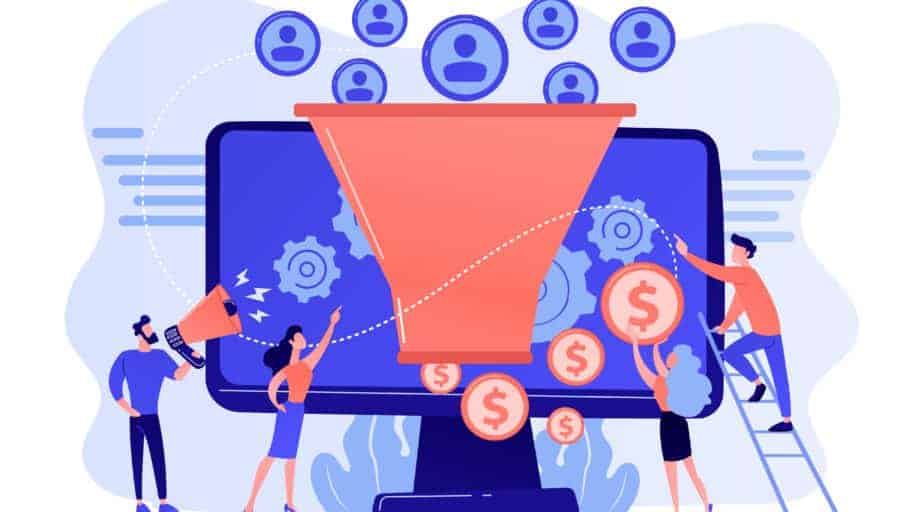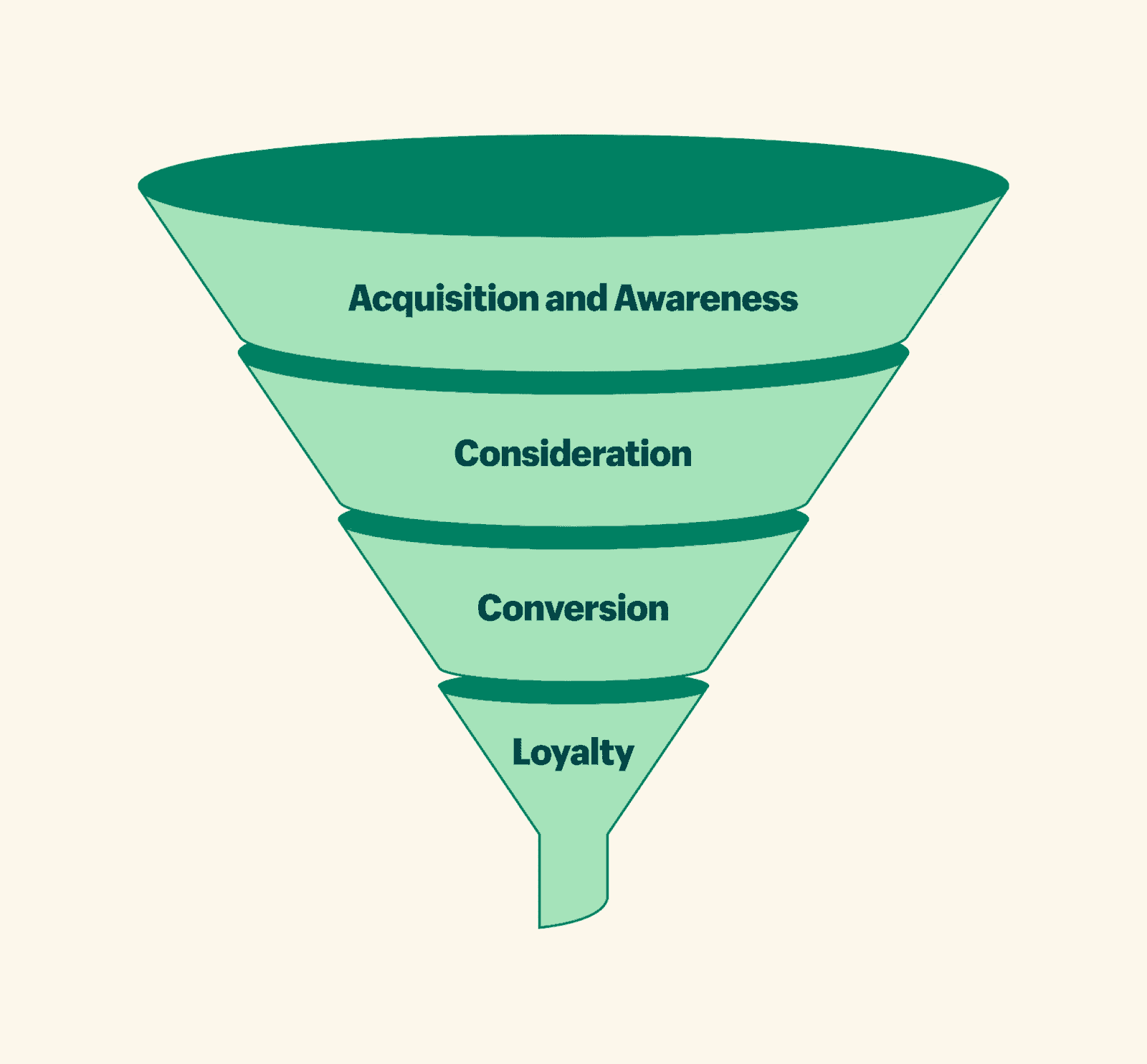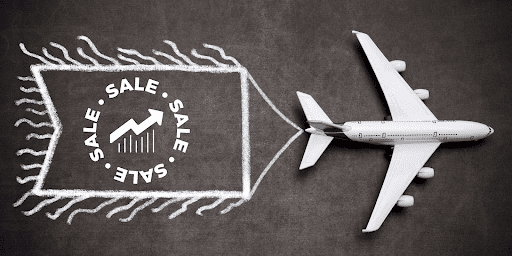The Marketing Funnel Stages and Strategies
- Datameer, Inc.
- June 9, 2022

What is Funnel Analytics in Marketing?
The word Funnel is commonly used to identify a tube-like object with a wide top and a narrow bottom.
In marketing, it’s very similar.
A marketing funnel denotes a consumer-focused marketing model that illustrates a customer’s journey from the time of interest (wide top) to purchasing a product or service(narrow bottom).
The funnel approach is a methodology that helps you track a customer’s journey from customer awareness to the final conversion stage.
The Marketing Funnel: A Strategy to Decrease Your Conversion Problems
Now that we understand the basics, let’s take a deeper look into the typical marketing funnel stages.

Understanding the inner workings of a working funnel will assist you in identifying conversion problems within your Funnel and proffer ideas on optimization strategies for your Funnel.
What Are the Marketing Funnel Stages?
1. Top of The Funnel (TOFU)_Awareness
- Brand Awareness
2. Middle of The Funnel (MOFU): Consideration
- Interest
- Evaluation
3. Bottom of The Funnel (MOFU): Conversion
- Trial (Micro)
- Loyalty/ Adoption (Macro)
Let’s explore the above stages in more detail.
1. The Top of The Funnel (TOFU)
The top of the Funnel denotes the awareness stage. i.e., The stage where your brand/software/service starts gaining traction.
By conceptually creating a wider top, you can pull in more visitors.
One way to achieve this is via brand awareness.
Brand Awareness
You can leverage Digital marketing channels like social media, ad platforms, and email marketing to increase your brand awareness.
The ads, SEO, and page interaction metrics on your digital marketing platforms offer insight into what’s engaging your audience and what’s not.
So by monitoring your digital marketing channels, you can act on your results to effectively expand your reach.
2. Middle of The Funnel (MOFU)
Interest –
With the awareness stage set up correctly, we can assume we have sparked the interest of our customers.
At this stage, your intended customer begins to explore products or services on your site that pique their interest.
Evaluation-
The next sub-phase is often referred to as the Desire Phase and is the second and most crucial part of the Consideration stage.
At this stage, a customer knows what they want and has most likely found your solution to be a good fit.
However, the customer may want to try out a demo to get a feel of the service or product before final purchase.
This is where you sell your brand. You can achieve this by channeling your brand story, sharing testimonials from past clients, and, if possible, offering personalized discounts or trial versions of your service or product.
3. Bottom of The Funnel (MOFU): Conversion-
Trial: Conversion (Micro)-
This is known as the Action to Convert Phase, the goal of every Marketer.
This is the bottom of the Funnel, and you have pretty much achieved your goal of converting leads.
Loyalty/ Adoption: Conversion (Macro)-
This stage is known as the retention stage.
This stage requires a customer to put in the effort to stick with your brand beyond first-time commitment or purchase.
Your brand becomes a go-to , as the consumer now becomes a channel/ source that generates other leads.
Strategies Proven to Increase Customer Conversion Rates
We have covered in-depth the structure of a working funnel.
This section will discuss how to increase your customer conversion rates with the funnel strategy.
1.Channels-
Increasing your conversion rates is by effectively leveraging your marketing channels.
It would be best to identify the numerous sources with a high probability of pulling more conversions towards your funnel’s bottom.
A few channels to look into are:
Email Marketing Channels-.
According to research by snov.io, 37% of email marketers named Email marketing the most reliable source for retaining customers. This is an effective way to increase your ROI and improve conversion rates.
SEO Optimization/ UX Experience-
Another way to ensure the conversion is by avoiding lousy SEO practices and poor User experiences on your website.
According to Google marketing strategies, 53% of leads exit a page if it takes more than 3 seconds to load.
Therefore, it is essential to explore website builders and hosts with low downtime and fast loading capabilities before getting a website.
Creating, Managing, and Distributing Marketable Content:
- Creating a Story for your Brand
- Leveraging Neuroscience to enhance user experience
- Writing Blog Posts, Creating Articles, and Publishing E-Books
- Creating Promotional Videos
2.Segmentation –
Segmentation is lead grouping, a way to improve your conversion rates.
Segmentation helps you to:
- Identify and utilize sources that can generate more leads for your brand in your funnel path.
- Group these leads into the respective stages in the Funnel.
- Identify their interaction with your brand.
- Attribute them to their proper persona.
Sounds pretty daunting, right?..not to worry!
We’ve identified some Marketing data-driven Funnel Analytical tools that can help.
Five (5) Marketing Funnel Analytical Tools –
- PIWIK Analytics Pro– With PIWIK Analytics, you can group your visitors into the various micro- segmented funnel buckets. It also provides you with a funnel report, integration with Google analytics, and can be used on mobile phones.
- Katra – Although quite expensive, it is an all-in-one funnel software primarily built for marketers. It works as an automated Email Marketing tool, has CRM features, and doubles as a website builder. It can be integrated with other Marketing funnel tools like Zapier, Braintree, etc.
- Report Builder with Excel- Easy-to-use and cost-effective, the Report Builder add-in in Excel helps you create mind-blowing funnel conversion buckets.
- Snitcher– This is more of a Lead-Tracking tool. Its best feature is the Google Analytics tracking feature, which helps identify when your site is visited by a potential customer and what actions were taken by that customer.
- Funnelytics is a funnel mapping and visualization Software with available pre-existing funnel templates and a drag and drop feature that makes it easier to build and segment your funnels.
The Last Piece of Your Marketing Funnel Stage Strategy
Marketing Funnel Stage analysis can help businesses visualize, map, and analyze their customers.
With your new found knowledge of Funnel and a basic understanding of marketing analytics and data warehouses , you are well on your way to increasing your conversions.
However, this is only part of the picture. Without the right marketing data warehouse, you still lack that 360 view of your customer, that view that offers you insight across all attribution touch points.
Consolidate your marketing data in Snowflake today and leverage the powerful modeling capabilities of Datameer for proper analysis.
Please don’t take my word for it….Explore our free trial today!


